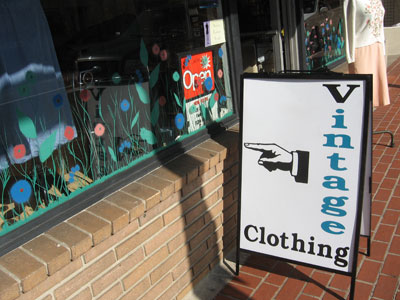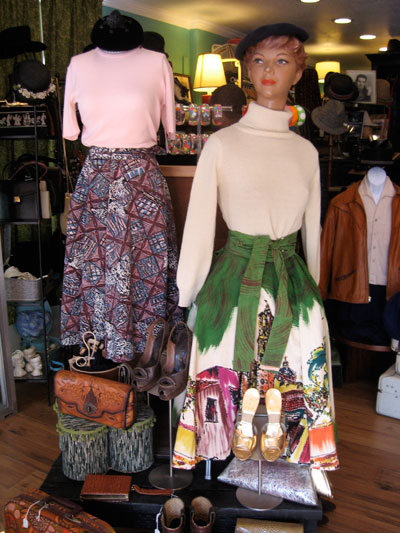One impact of the recession has been a fundamental change in consumer clothing purchase patterns. Luxury retailers’ losses have been second-hand retailers’ gains. Internet marketers have also been uniquely positioned to benefit.
Instead of buying new goods, more shoppers are turning to second-hand bargains. Thrift stores, with their low prices, are rising in popularity. As an added bonus, shoppers can walk away with vintage goods that might be worth more than their price tags indicate, because most thrift stores do not check the labels on goods and price them accordingly. (I cannot resist mentioning that I personally recently found a Free People skirt for $5.95 at Goodwill. Still attached was the original store tag: $144.00. )
Even small vintage boutiques that cater to a higher-end shopper — in Los Angeles, for example, Decades, Resurrection, and The Way We Wore — are actually faring quite well during these difficult economic times. More clothing is available for purchase by vintage store owners as people scramble to come up with extra cash. This allows the stores to choose from a larger selection, and consequently, have greater control over the quality and quantity of their stock. More clothing also equals a faster turnover of goods, keeping the racks refreshed. This means the stock of the store is more appealing to frequent customers who are most likely to make purchases.
 According to an employee at a San Francisco location of Buffalo Exchange, a nationwide, youth-oriented second-hand chain, “More people have definitely been trying to sell [to us], but the number of customers has surprisingly increased as well.” This is partially due to the quicker rotation of stock, but also because customers are searching for high quality clothing at lower prices. Vintage fashion items are usually made out of sturdier fabrics and have superior construction to today’s clothing. For consumers who want affordable clothing that will last, vintage presents a great alternative.
According to an employee at a San Francisco location of Buffalo Exchange, a nationwide, youth-oriented second-hand chain, “More people have definitely been trying to sell [to us], but the number of customers has surprisingly increased as well.” This is partially due to the quicker rotation of stock, but also because customers are searching for high quality clothing at lower prices. Vintage fashion items are usually made out of sturdier fabrics and have superior construction to today’s clothing. For consumers who want affordable clothing that will last, vintage presents a great alternative.
Consumers are not the only ones with their eyes turned toward vintage fashion. Designers have recently been evoking the 1930s and 1940s in their newest lines, drawing parallels between the current economic recession and the Great Depression. Although reminding consumers of the Great Depression might seem like a poor marketing strategy, it also carries the message that the times will improve and the economic crisis will resolve just as the Great Depression did. The association of vintage items and longevity is also a boon, in that it makes their designs appear more like investments.
As this designer interest suggests, the trend is fueled by more than pure economics. Vintage items contain elements of nostalgia. To those people who actually lived during the period in which the goods were manufactured, they often call back positive memories. More significant from a marketing viewpoint, for those who are not old enough to have experienced the actual decade in which their vintage product was created, vintage still recalls what they perceive as more prosperous times in our nation’s history.
The notion that items can last despite the events of the time is part of a movement against the current cynicism towards the “disposable” culture. Vintage clothing is recognized as sturdy in an age of “planned obsolescence” with products made cheaply to intentionally break down and need replacement. Anything that has survived this long is viewed as a good investment over the inferior merchandise of today.
 Along with a rejection of the throw-away culture is a rejection of the mass-produced, seen-everywhere culture. The older a piece of clothing is, the less likely it is that other similar pieces have survived. It’s one of the few inexpensive ways to find unique, possibly even designer, clothing. There’ s also a counter-cultural element in not following the corporate legacies of stores like Macy’s, but instead creating new looks that differ from what current designers decide is in fashion.
Along with a rejection of the throw-away culture is a rejection of the mass-produced, seen-everywhere culture. The older a piece of clothing is, the less likely it is that other similar pieces have survived. It’s one of the few inexpensive ways to find unique, possibly even designer, clothing. There’ s also a counter-cultural element in not following the corporate legacies of stores like Macy’s, but instead creating new looks that differ from what current designers decide is in fashion.
The search for vintage clothing is about finding something completely original and rare that no longer exists, or does so only in small amounts. And what better tool speaks to finding unusual niches than the internet?
The internet has become an option where pricing has leveled out between the extremes of bargain hunting and pricey boutiques. This equilibrium of price has been achieved in part by the abundance of information available on the internet, not just about vintage fashion, but about how to price it correctly. The search features on sites such as eBay allow users to easily compare similar pieces of vintage fashion and determine if it is overpriced or not as unique as it might be perceived in a vintage store window.
Perhaps the most important innovation in the online realm of vintage fashion is the website etsy.com, which allows individuals to set up their own shops and sell handmade and vintage goods. What differentiates Etsy from competitors such as Amazon and eBay is the interface: consumers feel as if they are breezing through individual shops as they enjoy aesthetically appealing layouts and large high quality photographs. This ability to create personalized shops aimed at an audience searching for handmade and vintage items is the perfect resource for those searching for a venue in which to resell their thrift store finds and make them appeal as affordable and unique clothing.
The downside is the difficulty to determine authenticity in a virtual world. Unlike porcelain and glass, there is no simple black-light test to figure out the age of a fabric. On the other hand, online information abounds in relation to authenticating vintage fashion in general.
As the economy spins, fashion does as well: past to present, cast-off to coveted, retail to thrift shop. With the addition of the internet, yesterday’s twice-arounds may become tomorrow’s thrice-arounds.
Photos of Elsewhere Vintage in Orange, California by Elizabeth Iverson.
Elizabeth Iverson is a freshman at Chapman University in Orange, California. She is currently studying Film Production and wishes to pursue a career in the entertainment industry.












